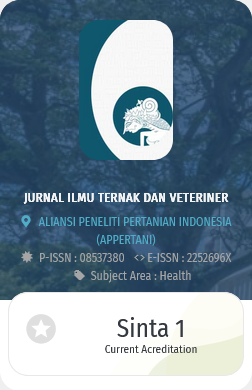Path analysis of exogenous variables against technology adoption levels of dairy cattle in West Sumatera
Abstract
Keywords
Full Text:
PDFReferences
Azis E, Kamal RM. 2017. Adopsi Teknologi belanja online konsumen UMKM dengan Model Unified Theory of Acceptance and Use of Technology. Creative Res J. 2:19-38.
Adnyana MO, Mardianto S. 2016. Dampak era globalisasi ekonomi terhadap usaha ternak sapi perah: Kajian Peluang, kendala dan strategi pengembangan. J Agro Ekonomi. 15:54-75.
[BPS] Badan Pusat Statistik. 2016. Populasi sapi perah menurut propinsi tahun 2009-2016. Jakarta (Indones). Badan Pusat Statistik.
Budiyono H. 2012. Analisis harga, impor dan ekspor susu. J LPPM: PARADIGMA. 9:207-212.
Diwyanto K, Priyanti A, Saptati RA. 2017. Prospek pengembangan usaha peternakan pola integrasi. J Penelitian Ilmu Peternakan. 5:26-33.
Farid M, Sukesi H. 2017. Pengembangan susu segar dalam negeri untuk pemenuhan kebutuhan susu nasional. Buletin Ilmiah Litbang Perdagangan. 5:196-221.
Fauzi A, Suharjo B, Syamsun M. 2017. Pengaruh sumber daya finansial, aset tidak berwujud dan keunggulan bersaing yang berimplikasi terhadap kinerja usaha mikro, kecil dan menengah di Lombok NTB. J Manajemen Pengembangan Industri Kecil Menengah. 11:151-158.
Ginting SP, Elisabeth J. 2014. Teknologi pakan berbahan dasar hasil sampingan perkebunan kelapa sawit. JITV. 19:227-233.
Gyau A, Smoot K, Kouame C, Diby L, Kahia J, Ofori D. 2014. Farmer attitudes and intentions towards trees in cocoa (Theobroma cacao L.) farms in Côte d’Ivoire. Agroforestry Systems. 88:1035-1045.
Hasan F. 2016. Evaluasi kebijaksanaan industri persusuan di Indonesia. J Agro Ekonomi. 12:48-65.
Kumaran M, Anand PR, Kumar JA, Ravisankar T, Paul J, Vimala DD, Raja KA. 2017. Is Pacific white shrimp (Penaeus vannamei) farming in India is technically efficient?—A comprehensive study. Aquaculture. 468:262-270.
Mathius IW. 2014. Inovasi teknologi pakan berbasis produk samping industri kelapa sawit. JITV. 19:9-24.
Narti S. 2016. Hubungan karakteristik petani dengan efektivitas komunikasi penyuluhan pertanian dalam program SL-PTT (Kasus Kelompok Tani di Kecamatan Kerkap Kabupaten Bengkulu Utara). J Professional FIS UNIVED. 2:40-52.
Nugroho E, Azizah S. 2014. Manajemen komunikasi pembinaan pelestarian plasma nutfah Sapi Rambon di Banyuwangi. J Ilmu-ilmu Peternakan. Univ Brawijaya J. 24:84-95.
Nuryanti S, Swastika DKS. 2016, August. Peran kelompok tani dalam penerapan teknologi pertanian. Forum Penelitian Agro Ekonomi. 29:115-128.
Rosandy RA, Putri SA, Santoso I. 2012. Analisis variabel-variabel yang mempengaruhi tingkat adopsi teknologi dengan metode Partial Least Square (Studi kasus pada sentra industri tahu Desa Sendang, Kec. Banyakan, Kediri). J Teknologi Manajemen AgroIndustri. 1:147-158.
Ruggiero S, Pieragostini E, Rubino G, Petazzi F. 2017. Impact of Mycobacterium avium subspecies paratuberculosis on profit efficiency in semi-extensive dairy sheep and goat farms of Apulia, southern Italy. Prev Vet Med. 136:56-64.
Saridewi TR, Siregar AN. 2016. Hubungan antara peran penyuluh dan adopsi teknologi oleh petani terhadap peningkatan produksi padi di Kabupaten Tasikmalaya. J Penyuluhan Pertanian. 5:55-61.
Sartika W, Rahmi E. 2012. Perkembangan populasi ternak besar dan unggas pada kawasan agribisnis peternakan di Sumatera Barat. Jl Peternakan Indonesia. 14:466-472.
Shiferaw B, Kebede T, Kassie M, Fisher M. 2015. Market imperfections, access to information, and technology adoption in Uganda: challenges of overcoming multiple constraints. Agric Econom. 46:475-488.
Sudaryanto T, Agustian A. 2017. Peningkatan daya saing usaha tani padi: Aspek kelembagaan. Analisis Kebijakan Pertanian. 1:255-274.
Suhaeti RN, Suharni S. 2017. Inkorporasi perspektif gender dalam pengembangan rekayasa alat dan mesin pertanian (Alsintan). Analisis Kebijakan Pertanian. 2:67-76.
Trinayani NN, Wandia IN, Puja IK. 2013. Asosiasi Keragaman lokus DNA Mikrosatelit DRB3 gen bola dengan berat badan induk dan berat lahir pedet pada sapi Bali. J Ilmu Kesehatan Hewan. 1:58-63.
Yusdja Y, Ilham N, Sejati WK. 2016. Profil dan permasalahan peternakan. Forum Penelitian Agro Ekonomi. 21:44-56.
Yusdja Y. 2017. Kebijakan ekonomi industri agribisnis sapi perah di Indonesia. Analisis Kebijakan Pertanian. 3:256-268.
Yuwono DM. 2017. Pengarusutamaan gender dalam pembangunan pertanian: Kasus pada pelaksanaan program feati di Kabupaten Magelang. SEPA J Sosial Ekonomi Pertanian Agribisnis. 10:140-147.
Refbacks
- There are currently no refbacks.

This work is licensed under a Creative Commons Attribution 4.0 International License.































